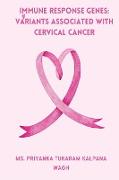- Start
- Immune Response Genes
Immune Response Genes
Angebote / Angebote:
Few STIs such as Chlamydia, Syphilis, Trichomoniasis and Gonorrhea can be cured, whereas viral infections such as Herpes Simplex virus (HSV), Human Papillomavirus (HPV), Hepatitis B and
Human immunodeficiency virus (HIV) are incurable. Diseases or symptoms due to
these viruses can be controlled by treatment . Among these, the Human papillomavirus (HPV) is the major causative agent of
cervical cancer (CaCx). Various benign and malignant lesions including anogenital
cancer and genital condyloma are associated with HPV. However, cervix is the main
target of HPV infection, in many it resolves itself, while in few others it persist and
may lead to cervical cancer. In India, 60, 078 women with cervical cancer die every
year with the incidence of 14.9 per 100, 000.
The cervix is the end part of the uterus, divided into ectocervix and endocervix.
Cervix connects uterus to vagina. Ectocervix is the outer part of the cervix
(Portiovaginalis) forming external OS and endocervix is the inner part of the cervix
forming a pathway connecting uterus i.e., channels between external and internal
OS. Size of the cervix varies with age, hormonal state, and parity.
Precancerous lesions in the cervix lead to cervical cancer. According to WHO
classification, mild dysplasia can progress to become moderate dysplasia, severe
dysplasia, and then progress to cervical cancer. Mild dysplasia may revert on its
own without treatment and usually does not progress to moderate or severe
dysplasia, except in few cases. Classification of cervical abnormalities is carried out
by two systems: First, are classified as CIN1 (Cervical intraepithelial neoplasia):
mild to moderate dysplasia, CIN2: intermediate dysplasia, and CIN3: severe
dysplasia and carcinoma in situ. According to Bethesda system Low grade
squamous intraepithelial lesion (LSIL) is CIN1, and CIN2 and CIN3 are considered
as High grade squamous intraepithelial lesion (HSIL). As per the International
Federation of Gynecology and Obstetrics (FIGO) invasive cancer is further
classified into various stages. Although cancer of the cervix can develop in women of all ages, the peak age is
usually between 35-55 years.
Fremdlagertitel. Lieferzeit unbestimmt
